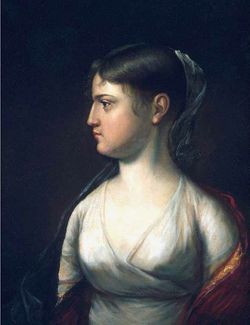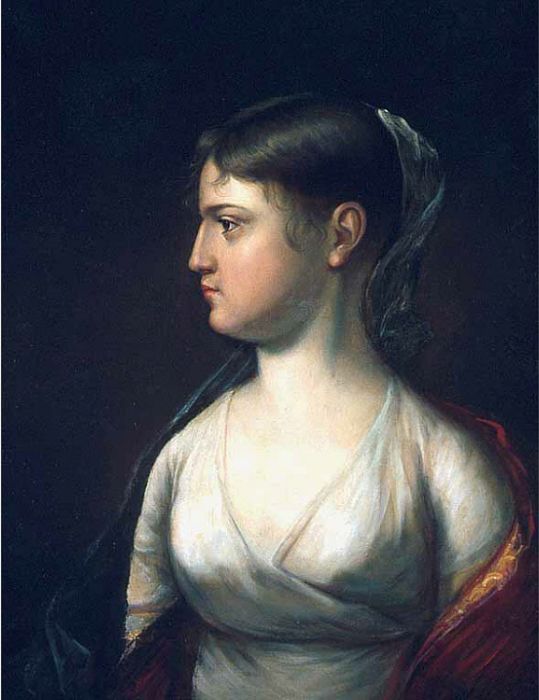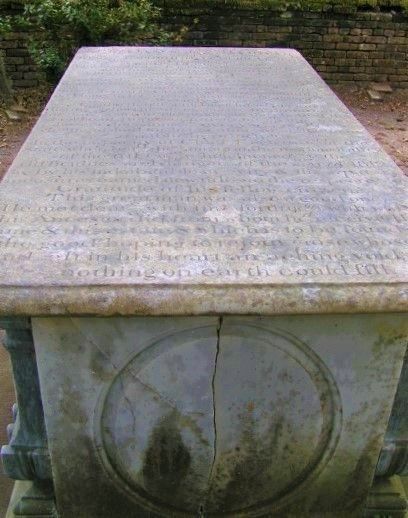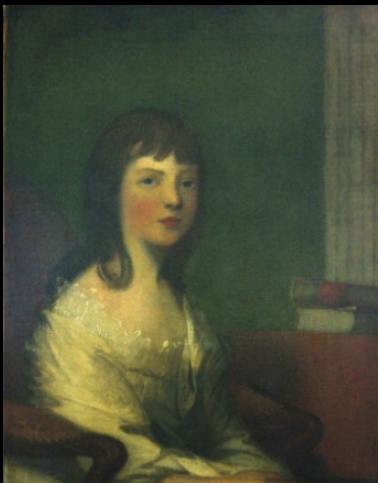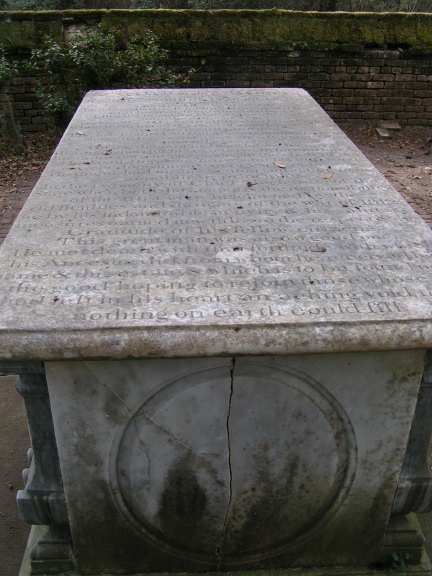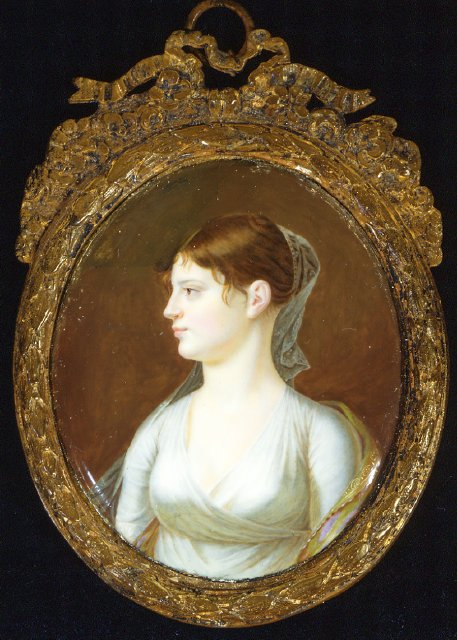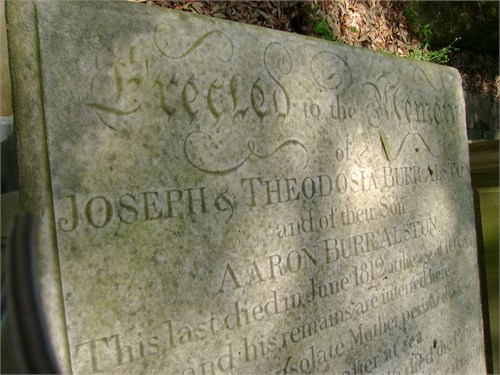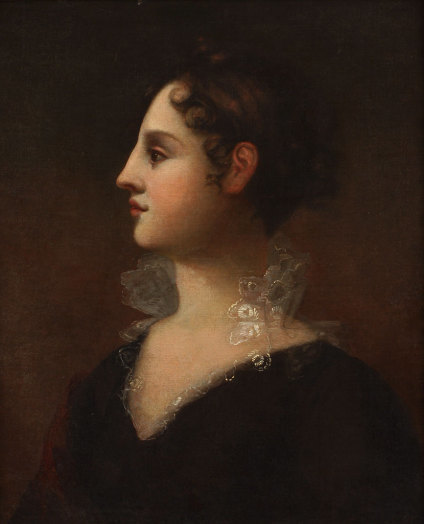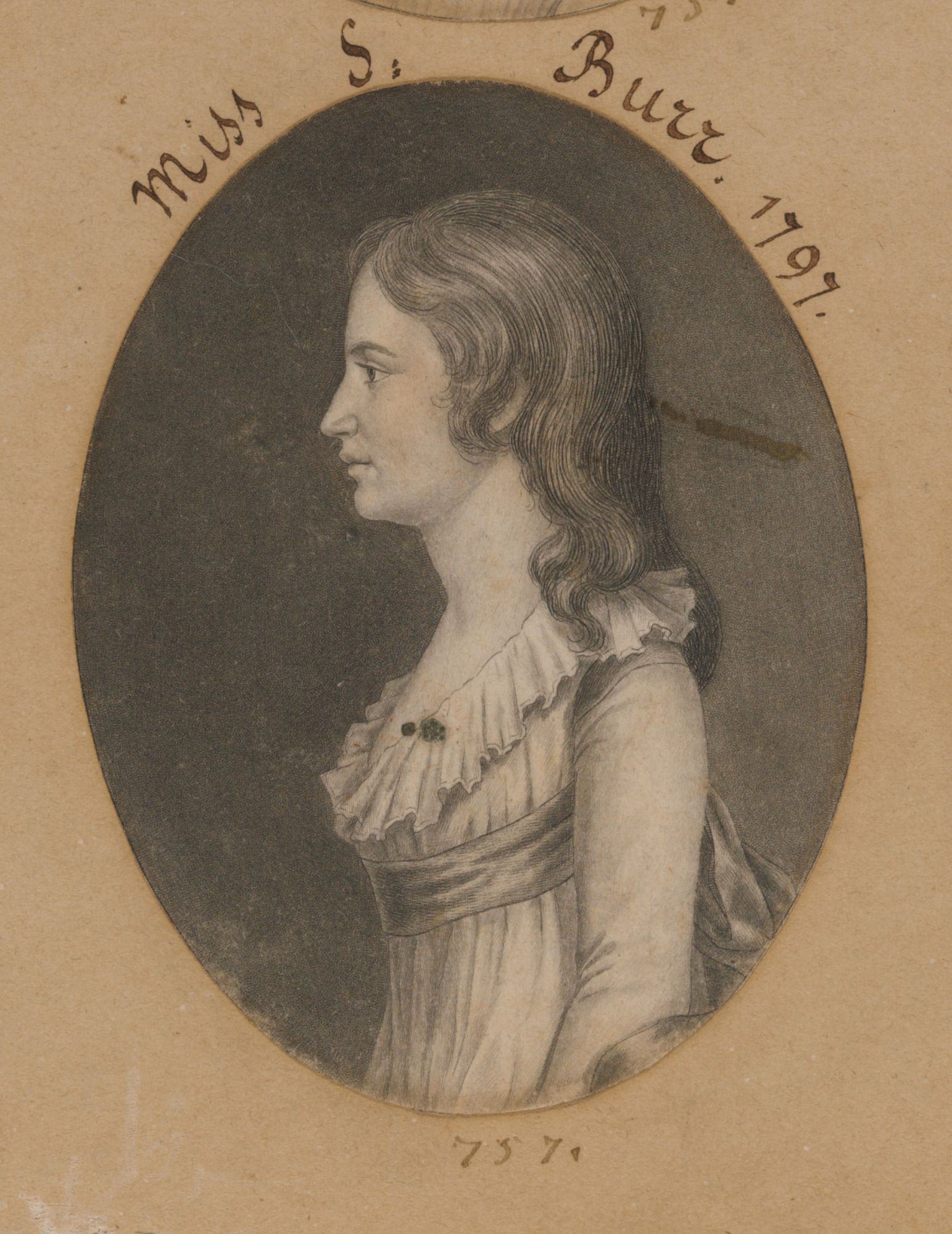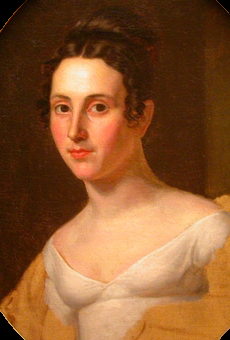Theodosia Burr Alston was born to Aaron Burr and Theodosia Bartow (Prevost) Burr in Albany, New York in 1783, a year after they married. Alston's mother was the widow of Jacques Marcus Prevost (1736-1781), a British Army officer who settled in New York City; she had five other children from that marriage and was nine years Burr's senior.
Alston was raised mostly in New York City. Her education was closely supervised by her father, who stressed mental discipline. In addition to the more conventional subjects such as French (the French textbook by Martel, Martel's Elements, published by Van Alen in New York in 1796, is dedicated to Theodosia), music, and dancing, the young "Theo" began to study arithmetic, Latin, Greek, and English composition. She applied herself to English in the form of letters to her father, which were responded to promptly, with the inclusion of detailed criticism. Their correspondence numbered thousands of letters.
Theodosia Bartow Burr died when her daughter was eleven years old. After this event, her father closely supervised his daughter's social education, including training in an appreciation of the arts. By the age of fourteen, she began to serve as hostess at Richmond Hill, Burr's stately home in what is now Greenwich Village. Once, when Burr was away in 1797, his daughter presided over a dinner for Joseph Brant, Chief of the Six Nations. On this occasion, she invited physicians David Hosack and Samuel Bard, and Bishop Benjamin Moore, among other notables.
In 1801, Theodosia married Joseph Alston, a wealthy landowner from South Carolina who would become the 44th governor of that state. They honeymooned at Niagara Falls, the first recorded couple to do so.[2] It has been conjectured that there was more than romance involved in this union. Burr agonized intensely and daily about money matters, particularly as to how he would hold on to the Richmond Hill estate. It is thought that his daughter's tie to a member of the Southern gentry might relieve him of some of his financial burdens. The marriage to Alston meant that Theo would become prominent. Her letters to her father indicated that she had formed an affectionate alliance with her husband. The couple's son, Aaron Burr Alston, was born in 1802.
Following the baby's birth, Alston's health became fragile. She made trips to Saratoga Springs, and Ballston Spa, New York, in an effort to restore her health. She also visited her father and accompanied him to Ohio in the summer of 1806, along with her son. There, Aaron met with an Irishman, Harman Blennerhassett, who had an island estate in the Ohio River in what is now West Virginia. The two men made plans which were later joined by General James Wilkinson, however, what exactly those plans were is not definitively known due to lack of supporting evidence for any of the popular allegations.
In the spring of 1807, Burr was arrested for treason. During his trial in Richmond, Virginia, Alston was with him, providing comfort and support. Burr was acquitted of the charges against him but left for Europe, where he remained for a period of four years.
While her father remained in exile, Alston acted as his agent in the U.S., raising money which she sent to him, and transmitting messages. Alston wrote letters to Secretary of the Treasury Albert Gallatin and to Dolley Madison in an effort to secure a smooth return for her father.
Alston's son succumbed to malaria and died on June 30, 1812, at age ten. The resulting anguish affected her health, to the point of preventing her from traveling to New York upon her father's return from Europe in July 1812. Unable to join him, she had to wait until December before she could make the journey.
Several months after the War of 1812 broke out, Alston's husband was sworn in as governor of South Carolina on December 10. As head of the state militia, he could not accompany her on the trip north. Burr sent Timothy Green, an old friend, to accompany her instead. Green possessed some medical knowledge.
On December 31, 1812, Alston sailed aboard the schooner Patriot from Georgetown, South Carolina. The Patriot was a famously fast ship, which had originally been built as a pilot boat, and had served as a privateer during the war, when it was commissioned by the U.S. government to prey on English shipping. It had been refitted in December in Georgetown, its guns dismounted and hidden below decks. Its name was painted over and any indication of recent activity was entirely erased. The schooner's captain, William Overstocks, desired to make a rapid run to New York with his cargo; it is likely that the ship was laden with the proceeds from its privateering raids.
The Patriot and all those on board were never heard from again.
Theodosia Burr Alston was born to Aaron Burr and Theodosia Bartow (Prevost) Burr in Albany, New York in 1783, a year after they married. Alston's mother was the widow of Jacques Marcus Prevost (1736-1781), a British Army officer who settled in New York City; she had five other children from that marriage and was nine years Burr's senior.
Alston was raised mostly in New York City. Her education was closely supervised by her father, who stressed mental discipline. In addition to the more conventional subjects such as French (the French textbook by Martel, Martel's Elements, published by Van Alen in New York in 1796, is dedicated to Theodosia), music, and dancing, the young "Theo" began to study arithmetic, Latin, Greek, and English composition. She applied herself to English in the form of letters to her father, which were responded to promptly, with the inclusion of detailed criticism. Their correspondence numbered thousands of letters.
Theodosia Bartow Burr died when her daughter was eleven years old. After this event, her father closely supervised his daughter's social education, including training in an appreciation of the arts. By the age of fourteen, she began to serve as hostess at Richmond Hill, Burr's stately home in what is now Greenwich Village. Once, when Burr was away in 1797, his daughter presided over a dinner for Joseph Brant, Chief of the Six Nations. On this occasion, she invited physicians David Hosack and Samuel Bard, and Bishop Benjamin Moore, among other notables.
In 1801, Theodosia married Joseph Alston, a wealthy landowner from South Carolina who would become the 44th governor of that state. They honeymooned at Niagara Falls, the first recorded couple to do so.[2] It has been conjectured that there was more than romance involved in this union. Burr agonized intensely and daily about money matters, particularly as to how he would hold on to the Richmond Hill estate. It is thought that his daughter's tie to a member of the Southern gentry might relieve him of some of his financial burdens. The marriage to Alston meant that Theo would become prominent. Her letters to her father indicated that she had formed an affectionate alliance with her husband. The couple's son, Aaron Burr Alston, was born in 1802.
Following the baby's birth, Alston's health became fragile. She made trips to Saratoga Springs, and Ballston Spa, New York, in an effort to restore her health. She also visited her father and accompanied him to Ohio in the summer of 1806, along with her son. There, Aaron met with an Irishman, Harman Blennerhassett, who had an island estate in the Ohio River in what is now West Virginia. The two men made plans which were later joined by General James Wilkinson, however, what exactly those plans were is not definitively known due to lack of supporting evidence for any of the popular allegations.
In the spring of 1807, Burr was arrested for treason. During his trial in Richmond, Virginia, Alston was with him, providing comfort and support. Burr was acquitted of the charges against him but left for Europe, where he remained for a period of four years.
While her father remained in exile, Alston acted as his agent in the U.S., raising money which she sent to him, and transmitting messages. Alston wrote letters to Secretary of the Treasury Albert Gallatin and to Dolley Madison in an effort to secure a smooth return for her father.
Alston's son succumbed to malaria and died on June 30, 1812, at age ten. The resulting anguish affected her health, to the point of preventing her from traveling to New York upon her father's return from Europe in July 1812. Unable to join him, she had to wait until December before she could make the journey.
Several months after the War of 1812 broke out, Alston's husband was sworn in as governor of South Carolina on December 10. As head of the state militia, he could not accompany her on the trip north. Burr sent Timothy Green, an old friend, to accompany her instead. Green possessed some medical knowledge.
On December 31, 1812, Alston sailed aboard the schooner Patriot from Georgetown, South Carolina. The Patriot was a famously fast ship, which had originally been built as a pilot boat, and had served as a privateer during the war, when it was commissioned by the U.S. government to prey on English shipping. It had been refitted in December in Georgetown, its guns dismounted and hidden below decks. Its name was painted over and any indication of recent activity was entirely erased. The schooner's captain, William Overstocks, desired to make a rapid run to New York with his cargo; it is likely that the ship was laden with the proceeds from its privateering raids.
The Patriot and all those on board were never heard from again.
Inscription
Sacred to the Memory of Joseph & Theodosia Burr Alston and their Son Aaron Burr Alston. This last died in June 1812 at the age of 10 years and his remains are interred here. The disconsolate Mother perished a few months after at sea. And on the 10th of Sept. 1816 died the Father, when little over 37 years of age, whose remains rest here with his Son's.
The lot of this Citizen was no common one to the state. To its service he devoted himself from early years. On the floors of its Legislature, he was distinguished for his extensive information & his transcendent eloquence; in the chair of the House of Representatives, for impartial, correct decisions; & every where, he was distinguished for his zealous attachment to republican principles.
In the capacity of Chief Magistrate of the State when both the honour & the responsibility of the trust were heightened by the difficulties and dangers of the war of 1812, he by his indomitable activity & his salutary measures earned new titled to the respect & the Gratitude of his fellow citizens.
This great man was also a good one. He met death with that fortitude with which his ancestor did from whom he received his name & this estate, & which is to be found only the good hoping to rejoin those whose loss had left his heart an aching void, that nothing on earth could fill.
